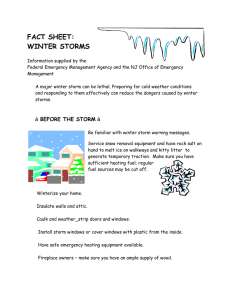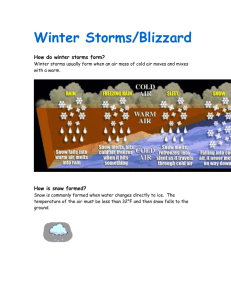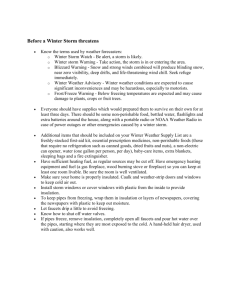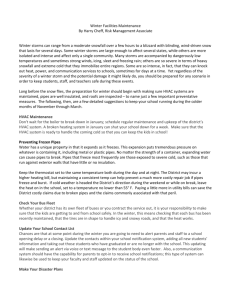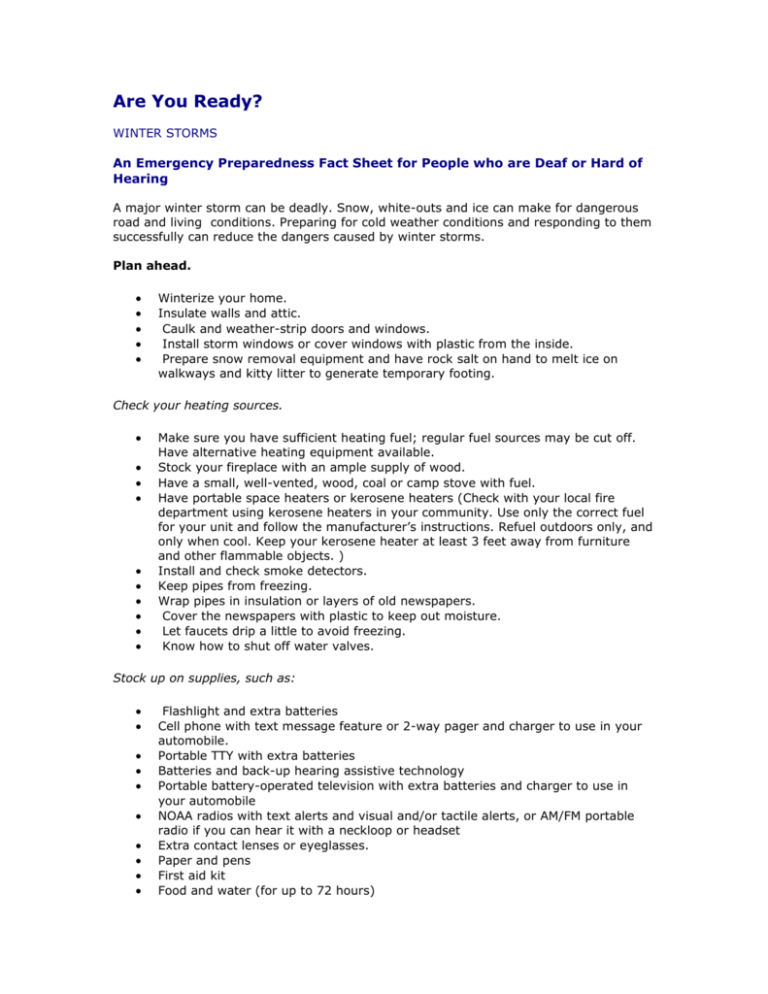
Are You Ready?
WINTER STORMS
An Emergency Preparedness Fact Sheet for People who are Deaf or Hard of
Hearing
A major winter storm can be deadly. Snow, white-outs and ice can make for dangerous
road and living conditions. Preparing for cold weather conditions and responding to them
successfully can reduce the dangers caused by winter storms.
Plan ahead.
Winterize your home.
Insulate walls and attic.
Caulk and weather-strip doors and windows.
Install storm windows or cover windows with plastic from the inside.
Prepare snow removal equipment and have rock salt on hand to melt ice on
walkways and kitty litter to generate temporary footing.
Check your heating sources.
Make sure you have sufficient heating fuel; regular fuel sources may be cut off.
Have alternative heating equipment available.
Stock your fireplace with an ample supply of wood.
Have a small, well-vented, wood, coal or camp stove with fuel.
Have portable space heaters or kerosene heaters (Check with your local fire
department using kerosene heaters in your community. Use only the correct fuel
for your unit and follow the manufacturer’s instructions. Refuel outdoors only, and
only when cool. Keep your kerosene heater at least 3 feet away from furniture
and other flammable objects. )
Install and check smoke detectors.
Keep pipes from freezing.
Wrap pipes in insulation or layers of old newspapers.
Cover the newspapers with plastic to keep out moisture.
Let faucets drip a little to avoid freezing.
Know how to shut off water valves.
Stock up on supplies, such as:
Flashlight and extra batteries
Cell phone with text message feature or 2-way pager and charger to use in your
automobile.
Portable TTY with extra batteries
Batteries and back-up hearing assistive technology
Portable battery-operated television with extra batteries and charger to use in
your automobile
NOAA radios with text alerts and visual and/or tactile alerts, or AM/FM portable
radio if you can hear it with a neckloop or headset
Extra contact lenses or eyeglasses.
Paper and pens
First aid kit
Food and water (for up to 72 hours)
Non-electric can opener
Cash and credit cards
Work or hiking shoes/boots to protect your feet
Develop an emergency communication plan.
In case your household members are separated from one another during a winter storm,
have a back-up plan where you can meet each other. Ask an out-of-state relative or
friend to be a contact person. After the storm, contact that person by pager or TTY. If
you don’t have a working TTY or pager, ask a hearing person with a cell phone to call for
you. Be sure each household member knows the name, address, and phone number of
the contact person.
If you are indoors:
Stay indoors and dress warmly. Conserve fuel.
Lower the thermostat to 65 degrees during the day and 55 degrees at night.
Close off unused rooms.
If the pipes freeze, remove any insulation or layers of newspapers and wrap pipes
in rags.
Completely open all faucets and pour hot water over the pipes, starting where
they were most exposed to the cold (or where the cold was most likely to
penetrate).
Watch television to get the latest information.
If you see broken or frayed wires, or if you smell hot insulation, turn off the
electricity at the main fuse box or circuit breaker. If you have to step in water to
get to the fuse box or circuit breaker, call an electrician first for advice.
Check for sewage and water lines damage. If you suspect sewage lines are
damaged, avoid using toilets and call a plumber. If water pipes are damaged,
contact the water company and avoid the water from the tap. You may obtain
safe water by melting ice cubes or using bottled water.
If you are outdoors:
Dress warmly. Wear loose-fitting, layered, light-weight clothing. Outer garments
should be tightly woven and water repellant. Mittens are warmer than gloves
because fingers generate warmth when they touch each other.
Stretch before you go out. If you go out to shovel snow, do a few stretching
exercises to warm up your body. Also take many breaks.
Protect your lungs from extremely cold air by covering your mouth when
outdoors.
Avoid overexertion. Cold weather puts an added strain on the heart. Exercise
such as shoveling snow or pushing a car can bring on a heart attack or make
other medical conditions worse. Be aware of sign of dehydration.
Watch for signs of frostbite and hypothermia. Keep dry.
Frostbite and Hypothermia
Frostbite is a severe reaction to cold exposure that can permanently damage its victims.
A loss of feeling and a white or pale appearance in fingers, toes, or nose and ear lobes
are symptoms of frostbite.
Hypothermia is a condition brought on when the body temperature drops to less than 95
degrees Fahrenheit. Symptoms of hypothermia include uncontrollable shivering, slow
speech, memory lapses, frequent stumbling, drowsiness, and exhaustion.
If frostbite or hypothermia is suspected, begin warming the affected person slowly and
seek immediate medical assistance. Use your own body heat to help. Arms and legs
should be warmed last because stimulation of the limbs can drive cold blood toward the
heart and lead to heart failure. Put the person in dry clothing and wrap his/her entire
body in a blanket.
Winter Storm Watches and Warnings
A winter storm watch indicates that severe winter weather may affect your area.
A winter storm warning indicates that severe winter weather conditions are definitely on
the way.
A blizzard warning means that large amounts of falling or blowing snow and sustained
winds of at least 35 miles per hour are expected for several hours.
Information adapted from materials by the Federal Emergency Management Agency
(www.fema.gov).
Questions? Comments? Contact the CEPIN Project at:
TDI, 8630 Fenton St. Suite 604, Silver Spring, MD 20910-3822
(301) 589-3006 TTY, (301) 589-3786 Voice, (301) 589-3797 Fax
http://www.tdi-online.org/
· info@tdi-online.org
Or contact one of our regional centers:
CSD of Oklahoma: www.c-s-d.org
DCARA: www.dcara.org
DEAF, Inc.: www.deafinconline.org
NVRC: www.nvrc.org
This project was supported by Cooperative Agreement Number 2004-GT-T4-K008
administered by the U.S. Department of Homeland Security, Office of State and Local
Government Coordination and Preparedness. Points of views or opinions in this document
are those of the author and do not represent the official position or policies of the U.S.
Department of Homeland Security
The CEPIN Project is coordinated by TDI and supported by by Cooperative Agreement Number 2004-GT-T4-K008
administered by the U.S. Department of Homeland Security, Office of Grants and Training. Points of views or
opinions in this document are those of the author and do not represent the official position or policies of the U.S.
Department of Homeland Security.
Copyright © 2006 CEPIN. All Rights Reserved.
Site design by Handsplash Creative Group.

